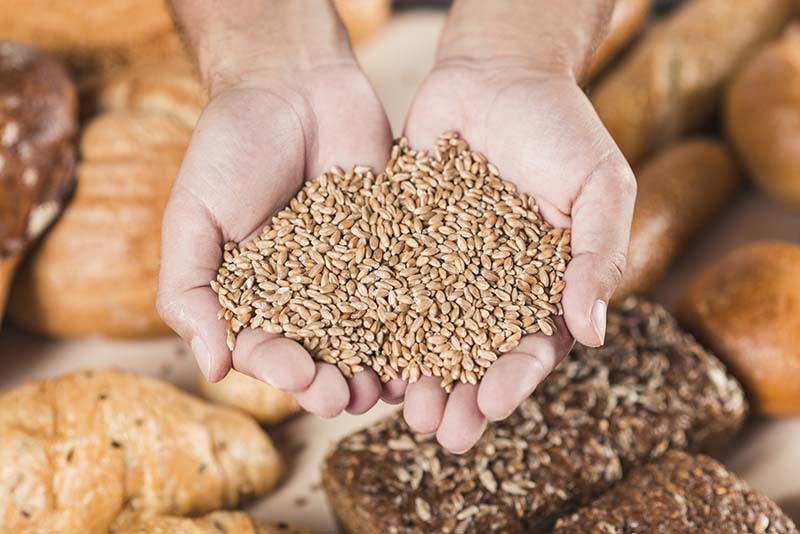Discover What are whole grain foods (Including Gluten-Free Options), that are rich in vitamins, minerals, and fiber. These healthy foods support digestion, boost energy, and benefit your entire body system. Yet, the question remains-where are gluten-free whole grains to be found?
This guide will teach us about the advantages of different whole grains, how we can consume them and introduce us to the world of whole grains. This list can help those individuals who do not eat gluten as well as the ones who like to consume grains to make a better decision on this topic. Let’s get started!
Benefits of Whole-Grain Consumption
Whole grain is packed with a variety of nutrients, hence it is an important part of a well-constructed diet. Let me share with you the rationale behind choosing them for your diet.
Grains that are nutrient-dense are full of fiber, vitamin B, iron, magnesium, and antioxidants. All of these components are highly beneficial for the well-being of the whole body system.
Healthy the fiber in whole grains supports digestion by making the bowel movements smooth, which in turn prevents constipation. Apart from that, it also makes a positive impact on the health of the intestine through beneficial bacteria feeding.
Strong the regular consumption of whole grains, which leads to full cholesterol reduction that combats possible heart illnesses to the minuscule. Grains provide the cardiovascular system with the necessary nutrients and at the same time have a positive effect on the blood system, improving the functioning of the blood vessel walls and reducing inflammation.
Slim the whole grains, owing to their ability to make you satiated for a longer time, are capable of diminishing hunger cravings and overeating. In addition, it will provide a slower and steadier digestion which prevents the sugar level in our blood from fluctuating and, consequently, stops the occurrence of energy crashes.
Ensures that you stay fit the fact that such food as the fiber in whole grains is not easily digested helps in the quick absorption of sugar leading to stable blood sugar levels and as a result, lower chances of getting diabetes. The intake of grains is regular to stay safe from the disease.
Besides according to the information obtained from the investigations, whole cereals can play a significant role in the reduction of colon cancer cases. Fibers take the first place when it comes to securing cell protection against the damage that may result from antioxidants.
One of the basic features of weight-loss programs is a slow digestion rate in whole grains which results in slow energy release over time. And as a consequence, they are a good option for consistent physical and mental activities.
Having different grains of whole ones in your diet can be a great solution for overall health. Hereinafter, we shall look into the most suitable gluten-free products and ways you can use them so that you do not miss out on any important things in your diet. Certainly, some of the following tips you will have previously heard, but we are all subject to forgetfulness, and repetition is always helpful when it comes to remembering things.
Understanding Gluten-Free Whole Grain Options
You must know that if you have celiac disease or gluten sensitivity, it is not that all whole grains contain gluten. Even so, they can always eat a plenty of the healthy grains. Look at the whole grains which are free from gluten and learn what to know here.
What Does Gluten-Free Mean?
Gluten, found in wheat, rye, and barley, is a protein that is bad for celiac and gluten illness sufferers so they need to avoid it.
Gluten-Free Whole Grains to Include
There are many grains that are still gluten-free in their original form and are a rich source of almost all nutrients:
Quinoa – A complete grain high in protein and all nine essential amino acids.
Brown Rice- A fiber-rich grain that is also a good source of energy.
Millet – A mild, versatile, magnesium, and antioxidant-rich grain.
Buckwheat – It actually does not contain gluten and apart from that it can also help you in lowering cholesterol and regulating blood sugar.
Amaranth – A legendary protein grain that also has anti-inflammatory capabilities.
Teff – A small-sized grain rich in iron and calcium.
Sorghum – A whole grain fiber that is good for digestion and blood sugar regulation.
Corn – It is an obvious fact that it is free from gluten besides being a rich source of antioxidants and fiber.
Avoiding Cross-Contamination
Actually, even gluten-free grains can be contaminated with gluten in the process of production. It’s better to pick certified gluten-free products that you remain free from trouble.
How to Use Gluten-Free Whole Grains
One can very well incorporate these cereals into one’s diet following these ideas:
Prepare quinoa or brown rice as a filling.
Opt for wheat or sorghum flour for making a sponge cake.
A good idea is to use millet or teff for oatmeal or the like.
Add amaranth to soups and stews.
Vitamins, fiber, and other nutrients found in the gluten-free cereals have numerous benefits to the health without the existence of gluten-related issues. Moving on to the following part, we will look at the whole grains that have gained popularity the most as well as their health benefits!
Types of Whole Oats
Oats are the best-selling kind of whole grains for the reason that they are jam-packed with fiber and provide a lot of health benefits. They are naturally gluten-free, but gluten may be introduced during the production, therefore it is okay to buy the tested and certified gluten-free oats.
Nutritional Benefits of Oats
It has a very high content of fiber, specifically the kind that is called beta-glucan, which is good for the heart.
Iron, magnesium, and B vitamins are also abundant vitamins and minerals.
Improve the cholesterol level and help to control the blood glucose level in the body.
It also makes one feel full, which is an advantage for weight loss.
Are good satiety consist, therefore, have a positive effect on weight management.
Types of Whole Oats
Whole Oat Groats – The least processed form, which still contains the bran, germ, and endosperm. They are the longest to be cooked but at the same time, they get the maximum nutrition center stage.
Steel-Cut Oats – This is oatmeal that is left after the groat is cut with a steel blade and is more or less the same texture and flavor. The cooking time is shorter than it is when you use whole oat groats, but it still takes about 20-30 minutes.
Rolled Oats (Old-Fashioned Oats) – These are now oat groats that are de-husked, steamed, and then flattened. The process made them easier to use for cooking. It is a culinary ingredient in oatmeal, baking, and smoothies too.
Quick Oats – These are slightly more processed than rolled oats, and as a result, they cook quickly and have a slightly smoother texture.
Instant Oats – They are the most processed ones and may even include pre-cooked and the first flavored variants. They are ready in just a few minutes and, on the downside, may contain some additional sweeteners or preservatives.
Ways to Work Oats into Your Diet
Create a warming bowl of oatmeal for your breakfast.
Throw oats into a smoothie for additional fiber.
Opt for oat flour while preparing a nice cake for yourself.
Assemble overnight oats together with fruits, nuts, and seeds.
Oats are a flexible and healthy whole-grain food that goes along well with any eating pattern. Now, let’s check what is what whole wheat is good about!
Exploring Whole Wheat Varieties
Whole wheat is one of the most commonly ingested grains. While refined wheat loses its bran, germ, and endosperm, the whole wheat remains unchanged, thus maintaining its fibers and other nutrients.
Health Benefits of Whole Wheat
Abounding in fiber – gives fuel to our colon and regulates our blood through a natural sugar cane process.
Loads with B vitamins – It is the key to power up the body and build the brain.
Has iron and magnesium – They help with the distribution of oxygen and work for the muscles.
Lowers the risk of heart disease – Fiber and plant substances are the way of experiencing a healthy heart.
What Are the Types of Whole Wheat
It still has the bran, germ, and endosperm. The whole wheat is the most natural shape of wheat, which is never broken, and it is supposed to be used in such dishes as soups, salads, and pilafs.
It is the flour that is most commonly used to prepare foods such as bread, pancakes, and I can add that it
Cracked Wheat (Bulgur) – Wheat that has been partially boiled and then broken is called cracked wheat. This type can get done in a very short time and most suitable for salads such as tabbouleh.
Whole Wheat Pasta – Nutrient-dense dish with good fiber; hence the ideal pasta over those of usual kinds.
Whole Wheat Bread – A fundamental substance for the making of sandwiches, usually milled from grains of wheat other than white.
How to Use Whole Wheat in Your Food
Switch out white bread for whole wheat bread.
Employ whole wheat pasta in preparing your most favored meals.
Substitute white flour with whole wheat flour in baking.
Combine bulgur or wheat berries with your salad or soup.
Whole wheat is a whole grain food that, in addition to being nutritionally dense, provides energy for a long time and supplies the body with the necessary nutrients. What’s next on our list is the amazing advantages of whole-grain rye. Let’s explore the grain.
Interesting Facts about Whole-Grain Rye
Rye is a deeply nutritious and vitamin-rich food with an earthy flavour, baked mainly for healthy snacks like bread, crackers, and cereals. This protein-rich grain is also extremely changeable.
As opposed to wheat, rye contains more fibrous elements, and is also absorbent to water, resulting in it being a quite filling and healthy choice.
Nutritional Benefits of Rye
Rye being high fiber leads to the activation of digestion, thus protecting the gut.
It improves the immune system with its antioxidant richness.
It is a mineral source, pumped with iron, magnesium, and phosphorus.
Rye fibers two fold the escalation in blood sugar, thereby decreasing the chances of diabetes.
The decrease of cholesterol levels is attributable in rye heart health support.
Types of Whole-Grain Rye
Rye Berries – Extremely high in fiber, unprocessed rye kernels are capable of becoming a main dish or a tasty addition to a salad.
Cracked Rye – These are only partially milled rye berries, which are normally served as a warm dish, and in the form of porridge.
Rye Flour – According to the use of rye flour, many times it is baked with it by many people or it is just used for bread mixed with wheat flour.
Pumpernickel – Pumpernickel as a nod to its hefty coarsely ground whole rye base comes somewhere first that is truly rye, and there is also a darker bread that is more compact.
Rye Crispbread – This is a snack that gives a light, grainy texture that is easy to digest and very crunchy.
How to Add Rye to Your Diet
If sandwiches or toasts for breakfast are your favorite things you can eat, you can replace wheat bread with a rye one.
Use rye flour in baking if you want to give the cake a special flavor.
Cook hot cracked rye cereal and have it for breakfast.
Snack on rye crispbread and top it with a healthy topping.
Rye can be a tasty and healthy whole grain that can be a great source of your health. Next, we will look at the advantages of barley!
Nutritional Value of Buckwheat
Named for its similarity to wheat, though buckwheat is not associated with this grain and is in fact gluten-free by nature. These are the characteristics of a whole grain which is rich in all the things needed to build up the strength and immune defense system.Named for its similarity to wheat, though buckwheat is not associated with this grain and is in fact gluten-free by nature. These are the characteristics of a whole grain which is rich in all the things needed to build up the strength and immune defense system.
Health Benefits of Buckwheat
It abounds in protein – that is, it contains all nine essential amino acids.
It is low in fat – the quantity of fat in food is low which is good for the digestive system.
It is full of antioxidants – it prevents diseases and infections and repairs damaged cells.
It improves the heart – it is good to keep cholesterol levels low and to have good blood flow in the body.
Buckwheat helps to control the blood sugar level – its value of glycemic index rate is low, so it is the best food for managing diabetes.
Types of Buckwheat
Raw buckwheat groats – This recording talks about the significance of the unpeeled and untreated seeds precisely being a foundation for kasha and salads.
Kasha – An example of roasted buckwheat, with a tasty taste and a roasted scent, widely consumed and known in the east part of Europe.
Buckwheat Flour – This flour in addition to baking is the carb that makes gluten-free pancakes.
Soba Noodles – Their various buckwheat flour types were the choice of Japanese cuisine to produce the so-called traditional Japanese noodles.
How to Include Buckwheat in Your Diet
How to Include Buckwheat in Your Diet
Prepare buckwheat groats as a breakfast porridge.
Bake pancakes, waffles, or desserts using buckwheat flour.
Mix kasha with soups or grain bowls.
Experience soba noodles in a stir-fry or a soup!
Buckwheat! It’s a delicious and gluten-free whole grain that you can use in various dishes and at the same time have super health benefits. Moving on to bulgur wheat and the delicious meals you can create with it!
Bulgur Wheat (Cracked Wheat)
Bulgur, also known as broken wheat, is a brand of whole grain that is produced through the process of boiling, drying, and breaking the wheat kernels in a salt session. It is a common ingredient in Middle Eastern and Mediterranean countries’ gastronomy.
Health Benefits of Bulgur Wheat
Fiber-rich – It makes digestion easy and the gut feels good.
Vitamin very rich in B – It secures the energy for you and the brain for normal operating.
It contains iron and magnesium – it is for oxygen to get to all parts of the body, in addition to the muscles’ well-being.
It is a blood sugar stabilizer – It helps reduce the amount of sugar you eat by making sure it is slowly absorbed without any sudden changes.
It is heart-healthy – It lowers your cholesterol and inflammation that affects your heart, giving a smooth function.
Types of Bulgur Wheat
Fine Bulgar – Convenient to make, tabbouleh (salad) is a nice example of its use regularly.
Medium Bulgur – This kind of bulgur is considered as the best variant for pilafs, soups, and side dishes.
Coarse Bulgur – This type is firm in consistency, and it is suitable to make dense soups and stews.
How to Include Bulgur in Your Diet
Tabbouleh salad should also be prepared with parsley, tomatoes, and lemon.
One can also use it in the place of rice when preparing pilaffs and soon in one-pot meals with grains.
It is to be taken in with soup, stews, etc. especially those that you want to be richer in texture and nutrition.
Add in the ground meat for getting healthier burgers or meatballs.
Bulgur is a healthy, fast way to fill your diet with multiple nutrients. Check out the benefits of millet shortly!
Millet
Millet is a gluten-free, small, and whole grain food that has been the main source of nutrition for many societies for many years. The grain has a lot of nutrients and offers many health-giving properties.
Health Benefits of Millet
Fiber-rich – Good for digestion and nourishing for the gut.
Loaded with antioxidants – Ward off inflammation and safeguard cells.
Keeps the heart in good condition – Lessens cholesterol and better blood flow.
Stabilizes blood sugar – Owing to its low glycemic index, it is perfect for diabetes control.
Great protein food – Helps in muscle growth and recovery.
Types of Millet
Pearl Millet – This is a type that most people use and make porridge, flatbreads, and soups with it.
Foxtail Millet – It is a type of iron-rich millet which used to be implemented into Asian cuisines.
Finger Millet (Ragi) – It is a good source of calcium that ensures proper bone health.
Proso Millet – Not very intense in flavor, it is ideal for salads and side dishes.
How to Include Millet in Your Diet
Prepare healthy porridge for the morning meal.
Millet introduce into your meals, as in the case of salads or stews, for a better texture.
Make other food like bread or pancakes by incorporating millet flour.
Unrestricted by wheat, millet is a gluten-free grain of small size that can be ingested by people who are on a diet. Now, you could have a look at the whole barley benefits!
Health Benefits of Whole Barley
Barley, a high-fibre nutrient-rich whole grain that has a chewy texture and a nutty flavour is a widely used grain in soups, stews, and grain bowls.
Health Benefits of Barley
High in fiber – Keeps digestion on track and helps with gut health.
Rich in beta-glucan – It is literally responsible for the decrease in cholesterol levels and improvement in heart health.
Regulates blood sugar – It slows down sugar absorption, which, in turn, leads to no blood sugar spikes.
Contains vitamins and minerals – Embracing iron, magnesium, and B vitamins in your meal.
Promotes fullness – Manages hunger and therefore assists in the control of food intake and weight loss.
Types of Barley
Hulled Barley – The best one as it has all the nutritious part i.e., and it is yet to be polished.
Pearled Barley – A type of barley that is processed more, but still contains all the nutrition it previously had, even without some parts of the grain – in this case, the bran.
Barley Flour – Flour is the item coming from barley which is used to bake instead of regular flour. It gives a nutty flavor and comes with extra fiber.
Barley Flakes – Excellent for making a simple and quick breakfast or a snack in combination with yoghurt, some fruit, and honey.
How to Include Barley in Your Diet
Barley can easily become part of your nourishment by throwing it into your soups and stews to make them more substantial.
Nowadays, it is very simple to carry it in a grain bowl, together with vegetables and protein, and thus, you can have your body’s daily energy and nutrient requirements met.
Change the carbohydrate of your meal by preparing barley as an alternative to rice.
Not to be forgotten, it is also good to mix barley flour in your baked recipes, as fiber is an important source of nutrition.
Barley is a rustic, wholesome whole grain with numerous possibilities. Next in line, we’ll find out the benefits of spelt!
Understanding Spelt as a Whole Grain
Spelt, a type of wheat that has been around for thousands of years, is often claimed to be considerably more nutritious and also much easier to digest than today’s wheat.
Health Benefits of Spelt
High in fibre – Aids the digestive system and keeps the levels of blood sugar normal.
High in Protein – Helps the repair and the growth of the muscles.
Loaded with vitamins and minerals – It has got Vitamin B, Iron, Magnesium, and Zinc in it.
Is full of antioxidants – Because of this, you can have less pain and your body can better fight infections.
Spelt is good for the heart – Resulting in less cholesterol and it provides the organism with better blood flow.
Types of Spelt
Whole Spelt Berries – This is the unprocessed raw form of spelt, very suitable when used in salads and cereal bowls.
Spelt Flour – Spelt flour made from whole grains is used to bake bread, pasta, and pancakes.
Spelt Pasta – This is a pasta made from spelt flour which is not only of course more nutritious but also gives a nutty flavor.
Spelt Flakes – These are similar to oats rolled and hence are excellent for breakfast or as a part of various baking recipes.
How to Use Spelt in Your Diet
You can bake bread, muffins, or cookies when you have spelt flour at your disposal.
Prepare a salad or a rice substitute by mixing the spelt seeds.
Prepare spelt pasta with vegetables and sauce.
Have spelt flakes for breakfast or as an ingredient in granola.
Spelt is a healthy and at the same time a very useful cereal that can easily be added to dishes. In the next chapter, we will learn about quinoa’s advantages!
Exploring Quinoa as a Whole Grain
Quinoa is a grain without gluten that is very healthy to use since it has good quality protein in abundance. Notwithstanding the fact that it is a seed from a botanical perspective, the product is regularly termed as a grain after going through certain stages in processing due to its countless nutrients.
Quinoa’s Benefits for the Body
Full protein – Provides all the vital amino acids, thus quinoa is the best substitute for a dairy product.
High in fiber – Assures the gut’s health as well as the sugar level is regulated by the same fiber.
Rich in vitamins and minerals – It has a lot of vitamins and trace elements like zinc, magnesium, and the B group of vitamins.
Gluten-free – People with Celiac disease or gluten intolerance do not get even a single health problem without their consumption of food grain containing this allergenic agent.
Antioxidants – are naturally occurring chemicals in food that help protect cells from harm.
Types of Quinoa
White Quinoa – Apart from that, most cooks love this flavorless quinoa with a sponge feeling when cooked.
Red Quinoa – Red quinoa is solid and has a distinct nutty taste that’s why it’s best for salads but the taste is not the same as black quinoa.
Black Quinoa – Being sweet in taste and chewy it not only engrosses the visual appeal of a dish and a drink as well but it is also high in nutrients which are necessary for health.
Tri-Color Quinoa – It’s a mixture of white, red, and black. The good thing about this product is that you can get different consistencies.
How to Add Quinoa to Your Diet
You should make your own really excellent stuff out of cooked quinoa by stirring some grain bowl or salad according to your preferences.
Combine the food with soups and stews to get some extra protein and taste it, too.
You can blend nuts and fruits which will give a rich, healthy meal in the morning, with porridge made of quinoa which will be very tasty and be a great option.
Trade some rice or couscous for quinoa, and you will get a delicious side dish!
Quinoa is a variety of grain that is gluten-free, and with the added advantage of being protein-rich and very healthy, it is perfect for many yummy dishes. The following chapter will talk about brown rice’s health benefits.
Health Benefits of Brown Rice
Brown rice is an unpolished grain that implies that its bran and the germ are still intact, putting it in a more nutritional position than the white sort. It is a variety of grain that is used in a wide array of dishes that are quite commonplace.
Nutritional Benefits of Brown Rice
High in fiber – Supports the digestive process and the regulation of blood sugar the most.
The minerals that are of the essence are primarily those of which magnesium, phosphorus, and selenium are good examples.
The use of antioxidants helps to reduce oxidative stress and inflammation when they are used.
Supports heart health – The cholesterol level drops and the risk of heart disease is lesser.
Gluten-free – Those who are gluten-sensitive or have celiac disease aren’t in danger.
Types of Brown Rice
Long-Grain Brown Rice – After cooking they become dry and separate which is perfect for side dishes and pilafs.
Short-Grain Brown Rice – These are wetter and more delicate and consequently, they are good for sushi and rice puddings.
Medium-Grain Brown Rice – These are gloopy but still a bit drier compared to short-grain which is why they are excellent for casseroles and stir-fries.
Brown Basmati Rice – It’s an aromatic kind that is mostly used by Indian and Middle Eastern cuisines.
How to Include Brown Rice in Your Diet
Rice can be a side dish served with fresh vegetables, beans, and protein.
Another option is to add rice to stir-fries or grain bowls for texture and nutrients advantages. Alternately, it can also be put into soups and stews as the major fiber source. With regard to the human aspect, some may even go to the extent of baking brown rice porridge for their dessert, a case in which, not only will it be a good option but also they will save time for other activities. Brown rice is a healthy and versatile whole grain that can easily substitute refined rice in most meals. How is maize as a whole grain advantageous? That’s the question we can answer in the following part of the text.
The Nutritional Value of Corn
Corn is an undeniably an essential food in many diets, a very versatile crop and its also a great source of energy. However, it can arrive in the form of whole kernels, corn flour, and cornmeal.
Health Benefits of Corn
Abundant in fiber – It helps in proper digestion by providing roughage and is good for cholesterol oxidation.
Loaded with antioxidants – Corn not only has lutein and zeaxanthin which are good for the eyes but also has these two in large amounts.
Rich in B vitamins – Good levels of thiamine, folic acid, and niacin are found in the grain.
Corn is a food of more vitamins than these – also that our body can also absorb magnesium, phosphorus, and potassium.
Devoid of gluten – The grain is still a healthy food for people with gluten intolerance or celiac disease.
Types of Corn
Whole Kernel Corn – This is whole corn kernel which is usually used in soups, stews or served as a side dish.
Cornmeal – A ground meal that results from the drying of corn kernels and is used for making cornbread, muffins, and pancakes. It is intriguing to find out that cornmeal is low in calories and fat and is a rich source of fiber and carbohydrates.
Popcorn – Exercising healthy eating habits is to be commended and especially when whole grains are involved, such as popcorn, which is an awesome source of nutrition that is created by corn kernels exploding. Nevertheless, it is good to be mindful as the calories can shoot up instantly once some butter and salt are added.
Corn Flour – It is the portion of the corn that has been milled into a fine flour and used for gluten-free baking and as a thickening agent. However, the problem with corn flour is that it contains no sugar, no protein, and no calcium (none of the essentials).
Hominy – It is corn treated with an alkali that removes the hull, and the kernels are used in grits or posole.
How to Include Corn in Your Diet
Not only is popcorn a healthy whole grain snack, but also it’s a time-saver because there is no waiting for it to soak and cook,
Cornmeal gets incorporated in the cooking of cornbread, muffins, or pancakes.
Stuff soups, stews, or salads with whole kernel corn as a topping.
From dough, you can make totally healthy corn tortillas which can be used for wraps and tacos.
Corn is a whole grain food that has a wide range of uses, which is a practical and healthy way to replace the main dish of any meal with a readily available alternative.
Whole-Grain Breads and Their Benefits
Whole-grain bread is made from whole grain flour, carrying all grain-parts to increase the number of nutrients and dietary fibers, in contrast to white bread. Carbohydrates come in all varieties of these breads.
Health Benefits of Whole-Grain Bread
High in fiber – It is good for digestion, controls blood sugar, it is a satiety agent.
Rich in B vitamins – Necessary for the production of energy and for the health of the brain.
Contains essential minerals – iron, magnesium, zinc, etc.
Supports heart health – This can lead to the reduction of cholesterol and is a preventive measure for heart disease.
Improves gut health – This will be possible by using a lot of fiber to make sure that the gut functions well (dyspepsia).
Types of Whole-Grain Breads
Whole Wheat Bread – It is made of whole wheat flour and the result is a bread that has a bulky texture, it’s very filling, and you get a good taste out of it.
Rye Bread – It is made of whole-grain rye flour, it is heavy and a little sour.
Multigrain Bread – It is a mixture of various whole grains such as oats, millet, and barley thus it has more nutrients.
Sourdough Bread – Generally, it is made of whole grain flours and that’s why it is tangy and it contains probiotics.
Spelt Bread – It is made out of whole spelt flour which gives a nice, sweet taste and the bread is a bit lighter than wheat.
How to Include Whole-Grain Bread in Your Diet
Create a whole-grain sandwich with lean protein and vegetables.
Include whole-grain bread in your morning items as it is easy to spread with some avocado or nut butter.
Using whole grain bread is a good way of making healthy and delicious croutons for your salads.
In standing alone, it is good to eat whole-grain bread but, if you accompany it with soup or some stew; you will have a more substantial and a healthier meal.
Whole-grain bread is an utterly delicious and satisfying food that you may eat. Do not miss the comparison of whole-grain and whole-wheat pastas!
Conclusion
Whole grain food is full of fiber, minerals, and vitamins. They help to maintain heart and gut health and control weight issues. The choice is huge – from oats, quinoa, brown rice, to gluten-free millet and popcorn. Any grain is nutritious. The first step is to replace the grains in your meals with whole grains. Another thing you can do is to use whole grain bread, pasta, and cereals. A large number of nutritious alternatives are out there, and incorporating whole grains into your diet is relatively easy, and it gives you a sense of satisfaction. Make a change to a healthier lifestyle and get rid of tiredness.











